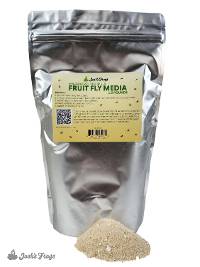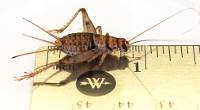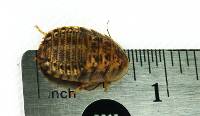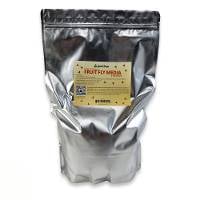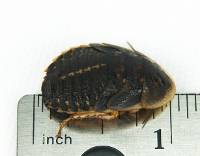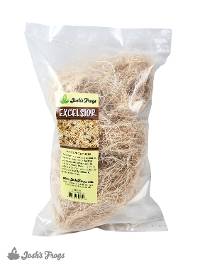Josh's Frogs
Blue Fang Skeleton Tarantula - Ephebopus cyanognathus | 1/2 inch (Captive Bred)
Blue Fang Skeleton Tarantula - Ephebopus cyanognathus | 1/2 inch (Captive Bred)
$79.99 0.0 out of 5 stars
(0)
0.0 out of 5 stars
(0)About This Product
Defining Characteristics:
- Ephebopus cyanognathus have a fast growth rate.
- It is actually the chelicerae (or fang housings) that are electric blue—not the fangs themselves!
- This is a smaller species, only getting between 2 and 3 inches
- They are a newer species, only having been discovered in 2000. It has been popular ever since
Name: Ephebopus cyanognathus also commonly known as Blue Fang Skeleton Tarantula or just Blue Fang Tarantula.
Recommended Enclosure Size & Setup: Ephebopus cyanognathus is a terrestrial species with some burrowing tendencies. Surface area of the enclosure should be no less than two times the spider's diagonal leg span in one direction and three times the diagonal leg span in the other. We recommend against allowing your terrestrial spider more than two times their diagonal leg span for head space above their substrate as a fall from any higher could result in serious injury.
The enclosure should be tall enough to accommodate 2-3 inches of substrate for slings and 4+ inches for adults. ABG mix, coco cradle, or Dig-It are all good substrate options for this species, but our Pet Bug Team prefers ABG all the way!
Want to spice up your enclosure with live plants? Our experts have curated kits of easy-to-care-for and SAFE plants for your tarantula. Check them out here!
Temperature (°F): This species thrives in the mid 70s to low 80s, so a temperature of 75 degrees is ideal. Temperatures regularly dipping below 65 or spiking above 85 degrees should be avoided.
A thermometer is recommended to keep an eye on temperatures in the enclosure.
Humidity: These spiders thrive in a humid environment, so the recommended ambient humidity should stay between 70% and 80%. This can be achieved by making sure the substrate is always slightly moistened. Depending on your location, you may need tools such as a humidifier to achieve this environment. A hygrometer is a great way to monitor the humidity for your animal and see if you need to make any adjustments to your husbandry.
The enclosure sides and décor should be spritzed lightly around 2 times a week to provide your spiderling droplets to drink from, but do not spray your spider directly.
Size: At the time of sale, this animal will be at least 1/2 an inch . Females can grow to be up to 3 inches, and typically the males are a bit smaller.
We use diagonal leg span to measure our spiders.
Age: Before making this species available to our customers, we ensure that they are well-established. This means our spiders are generally molted to a minimum of third instar and will have hatched two to three months prior to being listed for sale.
For spiders that we have not produced in house, we like to get two to three solid feedings in as well as the aforementioned minimums. They go through a 2 week minimum quarantine process to ensure the health of the animal.
For this species, the average lifespan is 3-4 years in males, and 15 years in females when provided an adequate environment.
Feeding: At the time of sale, this animal is eating a few hydei fruit flies once a week. Prey items should grow in size as the animal does. We recommend that the prey items not be much longer than the tarantula's “head” is wide. Larvae are an exception—our larvae are harmless. Since they are very high in fat, they're not the best staple diet, however they make a great weight gain supplement.
Remove uneaten prey items after 24 hours, these may stress your animal out or endanger the spider during molting. Never attempt to feed a freshly molted tarantula less than a week after their molt to prevent injury to the spider. Depending on its age, the hardening process could take anywhere from 48 hours all the way up to a week.
Sexing: Due to their age, Ephebopus cyanognathus sold by Josh’s Frogs are unsexed.
Coloration/Patterning: As spiderlings, Ephebopus cyanognathus have a metallic green abdomen, metallic blue chelicerae, bright orange/pink legs and a black carapace, making them an eye-catcher for anyone who sees them. As they mature, they become brown across their entire body, while continuing to keep the stunning blue chelicerae.
Social Behavior: Ephebopus cyanognathus is not a sociable animal and should be housed as an individual. Attempts at cohabitation will likely result in cannibalism.
Natural Range: Ephebopus cyanognathus are native to French Guiana.
Links of Interest:
- Arachnoboards: a community of spider enthusiasts that will be able to or have already answered almost any question you can think of with regards to tarantulas.
Still not sure if Ephebopus cyanognathusis from Josh's Frogs is the right pet bug for you? Read the reviews below and see what other customers are saying!
Shipping
After placing an order containing a live animal, you will receive a scheduling email containing our JotForm scheduling link to schedule your new pet's delivery date.
With this scheduling link, you will be able to schedule your order's delivery up to 30 days in advance. You will be able to choose a date of delivery for Tuesday-Saturday (Saturday arrival depends on the carrier's service availability) with the estimated time of arrival generally being 12pm, or 4:30pm for more rural areas. Overnight lows must be above 40°F to ship directly to you (or above 30°F for FedEx Ship Center pickups) as well as below 90°F by estimated time of arrival.
If you require further assistance, or prefer to talk to one of our Customer Service agents, please feel free to reach out to our [email protected] email or our phone line 1-800-691-8178.
Other Customers Also Bought
Customer Reviews
0.0 out of 5 stars
Review data
5 star reviews
- 0%
4 star reviews
- 0%
3 star reviews
- 0%
2 star reviews
- 0%
1 star reviews
- 0%

